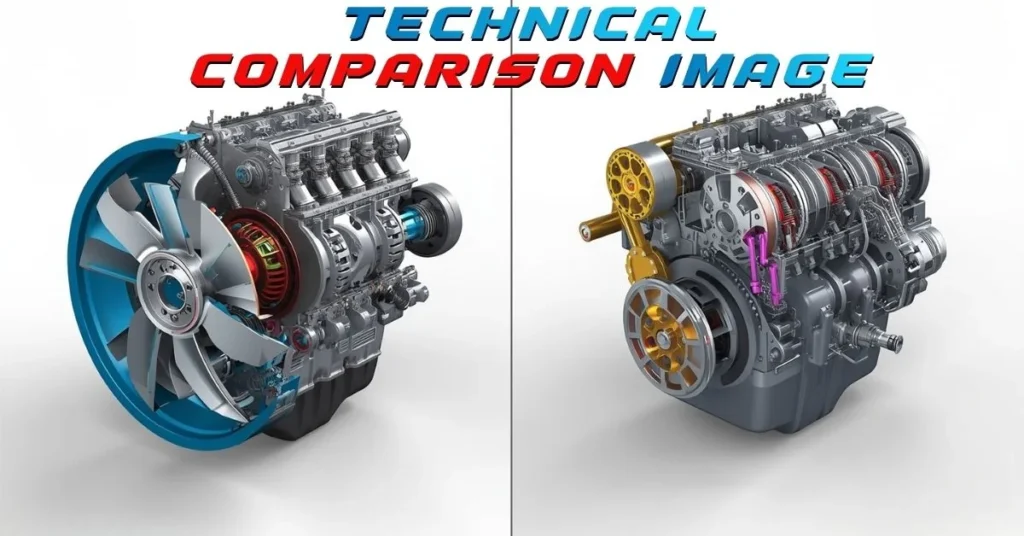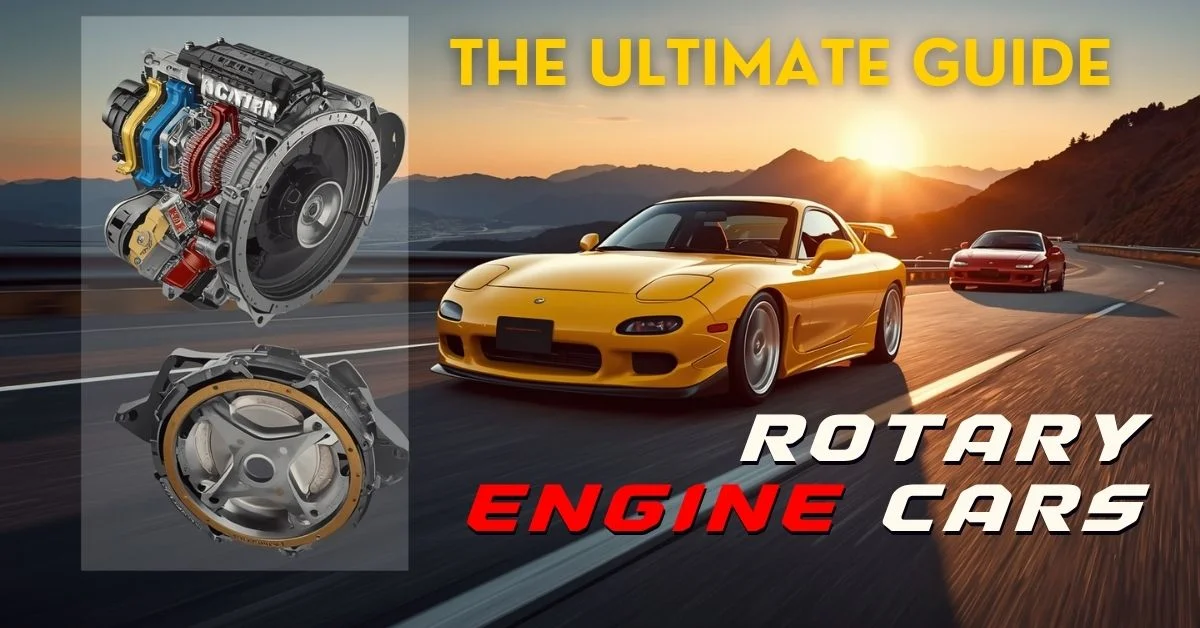Rotary engine cars are one of the most intriguing and unusual approaches to automotive propulsion in history. Unlike typical piston engines, which dominate the automobile landscape, rotary engines have a distinct rotating rotor architecture that delivers power in a completely different manner. These extraordinary powerplants have captivated the imagination of enthusiasts all over the world, offering a unique combination of compact size, high-revving performance, and distinct character that distinguishes them from traditional engines.
The rotary engine, often known as the Wankel engine after its inventor, Felix Wankel, works on a fundamentally different premise than typical reciprocating engines. While traditional powertrains, such as the dependable Honda K20 engine or the powerful BMW B58 engine, use pistons moving up and down in cylinders, rotary engines use a triangle rotor that spins within an epitrochoidal chamber, resulting in continuous combustion cycles with fewer moving components.
Understanding Rotary Engine Technology
Rotary engine cars have a unique design that eliminates the need for traditional pistons, connecting rods, and crankshafts. A rotary engine’s heart is a triangle rotor that rotates eccentrically within an oval-shaped housing, forming three combustion chambers that alternate between intake, compression, combustion, and exhaust phases.
This exquisite simplicity provides various advantages over traditional engines. Rotary engines are remarkably compact and lightweight when compared to piston engines of comparable output. Whereas a traditional engine, such as the Toyota 2AZ-FE, may require significant room for its cylinder block and valvetrain, a rotary engine produces comparable power in a much smaller compact. This compact design allows for better weight distribution and a lower center of gravity in rotary engine vehicles.
The smooth running of rotary engines is another significant advantage. Unlike piston engines, which have reciprocating action that causes vibrations, a Wankel engine’s continuous rotational motion results in remarkably smooth power delivery. This feature made rotary engine cars especially appealing to manufacturers looking for refined performance.
Iconic Rotary Engine Cars Through History
Mazda: The Rotary Pioneer
Mazda is the unquestioned champion of rotary engine vehicles, having dedicated decades in honing Wankel technology when other manufacturers abandoned it. The iconic Mazda RX-7 became synonymous with rotary performance, providing enthusiasts with an enticing blend of high-revving power, controlled handling, and a distinct engine sound that no piston engine could match.
The RX-8, the RX-7’s successor, built on Mazda’s rotary tradition with the groundbreaking RENESIS engine. The Mazda RX-8 engine had side intake and exhaust ports, which increased efficiency while retaining the high-revving nature that enthusiasts desired. This naturally aspirated rotary could reach 9,000 RPM, producing power in a linear, predictable manner that made the RX-8 one of the most enjoyable rotary engine cars to drive.
Mazda’s commitment to rotary technology resulted in numerous generations of performance vehicles that became cult favorites among enthusiasts. Traditional performance engines, such as the Hellcat or Dodge Viper, generated power through displacement and forced induction, whereas rotary engine vehicles obtained performance through high engine speeds and remarkable power-to-weight ratios.
Other Manufacturers’ Rotary Experiments
While Mazda controlled the rotary engine automobile market, other automakers experimented with Wankel technology. NSU pioneered production rotary vehicles with the Ro 80 sedan, demonstrating that rotary engines could meet practical transportation needs beyond sports automobiles. Citroën, Mercedes-Benz, and even General Motors studied rotary applications, but reliability and fuel efficiency difficulties eventually caused most manufacturers to forsake the technology.
Advantages of Rotary Engine Cars
Rotary engine cars offer several compelling advantages that continue attracting enthusiasts despite the technology’s rarity in modern automotive markets:
Compact Power Delivery: Rotary engines’ high power-to-weight ratio enables manufacturers to construct lightweight, nimble sports cars. This benefit is especially noticeable when comparing rotary engine cars to vehicles powered by conventional performance engines such as the Ford Mustang Coyote engine or the BMW N55 engine, which require substantially more room and weight to produce equivalent horsepower.
High-Rev Performance: Rotary engines can safely run at speeds that would destroy traditional piston engines. This high-revving capability provides an exhilarating driving experience that is exclusive to rotary engine vehicles, with power delivery remaining smooth and linear throughout the rev range.
Mechanical Simplicity: Theoretically, rotary powerplants have less mechanical complexity than piston engines because they have fewer moving parts. This simplicity stands in contrast to the complicated timing systems and valvetrains used by forced-induction installations or traditional engines like the Toyota 1GR-FE engine.
Balanced Design: In contrast to inline-four arrangements like the Honda Civic engine or Subaru FA20 engine, which need balance shafts to reduce vibration, the intrinsic balance of rotating components removes the vibration problems typical of piston engines.
Challenges Facing Rotary Engine Cars
While rotary engine cars offer certain benefits, they encounter considerable obstacles that have restricted their broad acceptance and led to a decrease in production over time:
Fuel Efficiency: The design of the combustion chamber in rotary engines presents difficulties in achieving complete fuel combustion, leading to reduced fuel efficiency when compared to contemporary piston engines. This drawback became progressively more concerning as emissions regulations became more stringent worldwide.
Oil Consumption: Rotary engine vehicles necessitate the injection of oil directly into the combustion chamber to lubricate the rotor tip seals, leading to a natural consumption of oil that is often deemed unacceptable by contemporary drivers. This characteristic fundamentally contrasts with traditional engines, where oil consumption serves as an indicator of wear or malfunction.
Emissions Compliance: The distinct combustion characteristics of rotary engines result in elevated emissions compared to similar piston engines, complicating regulatory compliance as environmental standards have progressed. Contemporary engines, such as the efficient Skyactiv-G engine, illustrate the progression of conventional technology, while the development of rotary engines has remained stagnant.
Apex Seal Durability: The apex seals, essential for maintaining compression in rotary engines, can be a significant failure point, especially in high-performance applications or vehicles that are not properly maintained. The reliability concern adversely affected the reputation of rotary engine vehicles, even though proper maintenance could alleviate many of the associated issues.

Maintaining and Modifying Rotary Engine Cars
Owners of rotary engine cars should be aware of the specific maintenance needs that these vehicles entail. Regular oil changes are essential, particularly in comparison to conventional engines, and adhering to the correct oil specifications is vital for the longevity of apex seals. Combining oil with fuel offers enhanced lubrication that numerous enthusiasts regard as crucial for the longevity of rotary engines.
The modification capabilities of rotary engine vehicles appeal to performance enthusiasts aiming to enhance the power output of these distinctive powertrains. Implementing turbocharging or supercharging in rotary engines results in significant power enhancements; however, forced induction introduces additional stress on apex seals and necessitates meticulous tuning. The aftermarket support for rotary engine vehicles, especially the Mazda RX-7 and RX-8 models, is comparable to that offered for widely recognized conventional performance platforms.
Individuals looking for alternatives to rotary power or in need of replacement engines may find that considering quality used engines offers a cost-effective solution for rotary engine vehicles that require powertrain replacement or engine swaps to conventional configurations.
The Future of Rotary Engine Cars
Mazda’s announcement regarding the return of rotary engine technology as a range extender in hybrid vehicles indicates a promising revival for Wankel power, albeit not in the conventional sports car context that historically characterized rotary engine vehicles. This application utilizes the benefits of rotary systems, including their compact size and smooth operation, while addressing the drawbacks by limiting operating duration and optimizing for specific ranges of operation.
The community surrounding rotary engine cars is characterized by its passion and commitment, bolstered by robust aftermarket support that guarantees these distinctive vehicles remain operational well beyond the cessation of manufacturer assistance. This level of dedication reflects the communities that have formed around other iconic engines, such as the renowned Toyota 2JZ, which continue to enjoy a devoted following even years after production has ceased.
Conclusion
Rotary engine cars exemplify an intriguing segment of automotive history, showcasing that innovative methods to internal combustion can achieve success despite various obstacles. Although traditional engines such as the LS6 motor and sophisticated Mercedes-Benz engines prevail in today’s automotive market, the distinctive nature and engineering finesse of rotary powerplants guarantee that these vehicles retain a loyal fan base.
For enthusiasts in search of a unique driving experience, the Mazda RX-7 and RX-8 stand out as accessible and engaging sports cars, delivering performance and character that are unmatched by traditional options. Whether you are maintaining an existing rotary-powered vehicle or contemplating entry into the rotary community, comprehending the unique characteristics of these engines guarantees a fulfilling ownership experience. For extensive automotive resources and high-quality components, visit our comprehensive blog that addresses all facets of automotive technology and maintenance.

